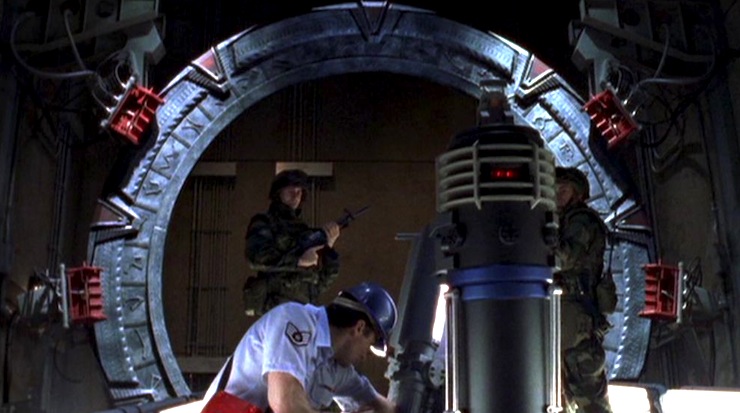Stargate SG-1: Season 1
Executive producers: Jonathan Glassner & Brad Wright
Co-executive producers: Michael Greenburg, Jeffrey King
Original air dates: July 27, 1997 – March 6, 1998
Mission briefing: Picking up one year after Stargate, we learn that O’Neill, Kawalsky, and Ferretti reported that the nuke went off, destroying the entire settlement on Abydos, killing Jackson. O’Neill then retired, and the Stargate program was mothballed. Personnel have been slowly rotated out of the lower levels of Cheyenne Mountain—until one day, when five airmen (well, four airmen and one airwoman, Sergeant Carol Weterings) are playing poker in front of the gate, covered in cloth. The gate activates, and Apophis comes through with several of his Jaffa (including his First Prime, Teal’c). Weterings is kidnapped and taken back through the gate, and the other four airmen are killed in a firefight.
General George Hammond, who has taken over command of Cheyenne from General West, gets O’Neill out of retirement and brings in Kawalsky and Ferretti. O’Neill admits the truth of what happened, and Hammond sends a team that includes the three survivors of the first mission, as well as Captain Samantha Carter, an astrophysicist who did quite a bit of work on the theoretical side of doping out the Stargate.
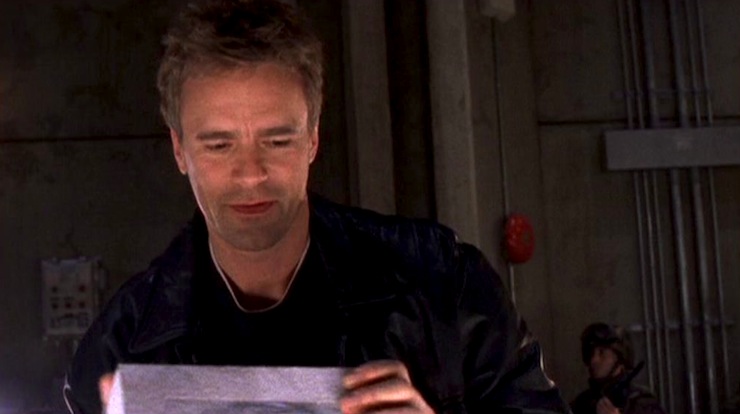
Upon returning to Abydos, they’re reunited with Jackson, Sha’re, Skaara, and the rest of the gang. Jackson reveals that he’s found a cartouche filled with gate addresses. Between them, he and Carter figure out that there’s a vast gate network, and the reason why none of the gate combinations they tried have worked is because of stellar drift over the thousands of years since the chamber was constructed.
Apophis shows up on Abydos, still kidnapping folks, this time taking both Sha’re and Skaara. Before lapsing into unconsciousness from the attack, Ferretti sees the address that Apophis enters into the dial-home device (DHD, the one thing they never found in Giza).
Jackson returns with the team, and Hammond announces that the president has authorized the formation of nine teams that will do reconnaissance through the various gate addresses that they’ve gotten from the Abydos cartouche. O’Neill and Kawalsky are given command of SG-1 and SG-2, respectively, with Carter and Jackson serving on the former. They go through the gate to Chulak. SG-1 is captured, after they learn that Apophis has selected Sha’re to host his bride Amonet (Weterings was considered and rejected by the symbiote, after which Apophis killed her), while Skaara has been chosen to host Klorel.
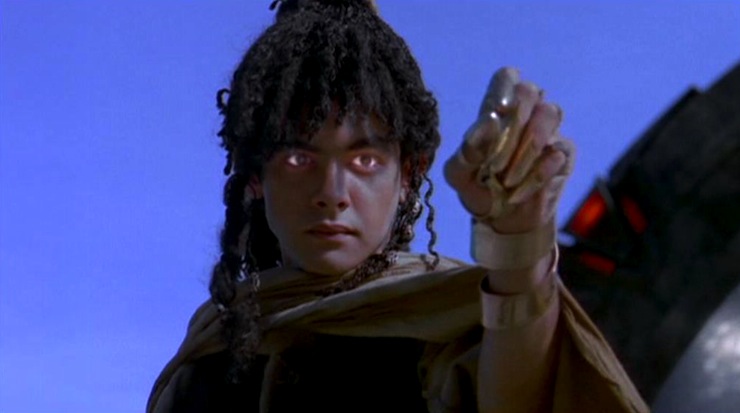
SG-1 escapes with Teal’c’s help. Seeing the technology of Earth, Teal’c believes that he has at last found allies who can help him rebel against the Goa’uld; he returns to Earth and eventually becomes part of SG-1. Stargate Command continues with its mission to explore and learn more about the greater galaxy, but O’Neill and Jackson have a personal stake, too: to find Skaara and Sha’re and rescue them from the Goa’uld that they have been forced to share their existence with.
Unfortunately, they have a more immediate problem: Kawalsky, who is also possessed by a Goa’uld. O’Neill is forced to kill his best friend in order to save him.
The SGC mostly explores via trial and error. SG-1 brings a disease that de-evolves people back to Earth, the leader of SG-9 goes rogue and takes over a planet by posing as a god the way the Go’auld do, O’Neill is infested with nanites that age him rapidly, SG-1 brings a young girl named Cassandra through the gate only to learn that she’s been implanted with a bomb, Jackson is kidnapped by an alien who’s trying to find his wife, and a scientist creates perfect android duplicates of SG-1 (who think they are SG-1).
And there’s more to the Goa’uld than Ra and Apophis. A dig in Mexico digs up Hathor in a sarcophagus, and she almost takes over the SGC with her ability to captivate men, but a female team led by Carter and Dr. Janet Fraiser (with help from Teal’c, also immune) take the base back.
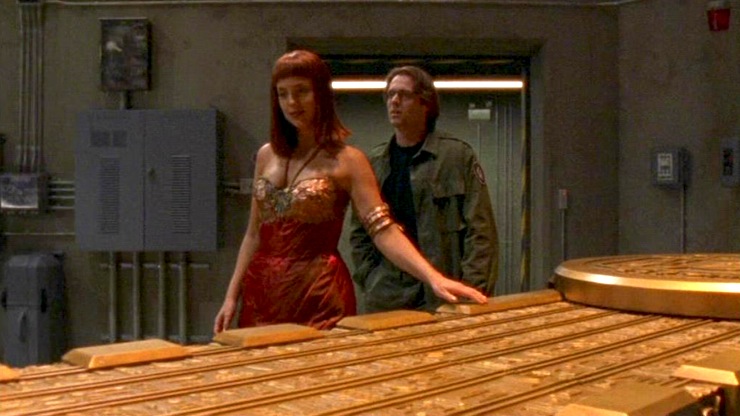
But they do find that it’s not just Goa’uld and Jaffa out there. They meet friendly advanced species the Nox and the Tollan, they learn of the Asgard, and they meet another ally among the Jaffa in Teal’c’s mentor, Bra’tac. Most impressively, they rescue the first person to go through the Stargate in the 20th century, Ernest Littlefield, the fiancé of Catherine Langford, who went through the gate in 1944 and was then lost. The planet Littlefield went to, Heliopolis, reveals the existence of four great races, who will eventually be identified as the Asgard, the Nox, the Furlings, and the Ancients.
In addition, Carter and O’Neill discover a second gate on Earth, located in Antarctica. So now they have a backup…
There are personal crises as well. O’Neill is forced to confront the pain of his son’s accidental suicide thanks to an alien creature that possesses him, Jackson is transported to an alternate reality in which Apophis invades Earth and kills millions, Carter has to confront her ex-fiancé, who’s gone nuts, while Teal’c faces the opprobrium of his wife and child, whose lives have been made miserable by Teal’c’s betrayal of Apophis (though they do come around eventually).
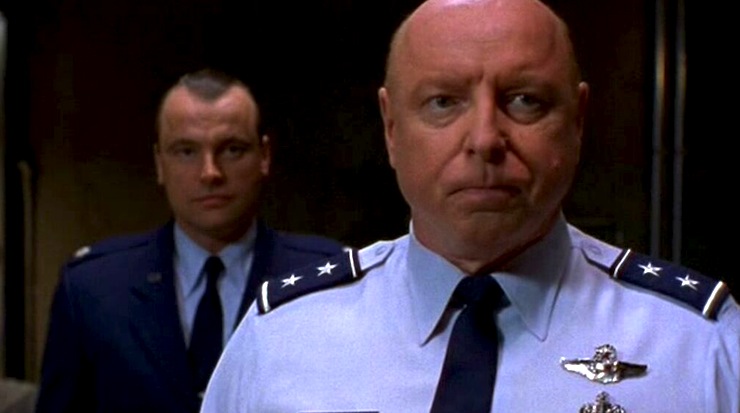
Politics at home are an issue, too, from the shadowy organization known as the NID, which has its own agenda for the Stargate and wants it out of Air Force hands, to Senator Robert Kinsey, the head of the appropriations committee, who views the Stargate as a dangerous and unnecessary expense.
Kinsey succeeds in shutting the SGC down, but then two Goa’uld motherships containing Apophis and Klorel, set course for Earth. And SG-1 may not be able to stop them…
Best episode: “Within the Serpent’s Grasp.” The first-season finale is a tense adventure, building on the fears stoked by Jackson’s alternate reality trip in “There But for the Grace of God…,” with the personal stakes of Skaara’s possession by Klorel affecting O’Neill, as well as Teal’c’s status as a traitor. And the cliffhanger is devastating, as the two motherships approach Earth.

Honorable mentions: The aforementioned “There But for the Grace of God…,” which does the alternate-reality episode that’s become a cliché since “Mirror, Mirror” on the original Star Trek, but which SG-1 does with devastating effectiveness here, using the concept to show what would happen if Apophis invaded without actually having Apophis invade.
“The Torment of Tantalus,” for bringing back Langford (and her father in flashback), showing the early experiments on the Stargate and setting the stage for the galactic history that all three TV shows would flesh out over the next several years.
“The Enemy Within,” a second episode that shows in depth what the Goa’uld do to people by its corruption of Kawalsky, a character we know and like.
“Enigma,” a very well written introduction to the Tollan, showing that not all the humans who were removed from Earth to develop on their own stayed primitive.

And “Children of the Gods,” which does a superb job of taking what was established by the movie and expanding it.
Worst episode: “Emancipation.” A dreadful cliché, retreading the same idiotic ground that the episode’s writer, Katharyn Powers, trod in the Star Trek: The Next Generation episode “Code of Honor,” and this one is only slightly better in that Amanda Tapping is a better actor than Denise Crosby and this episode also has Cary-Hiroyuki Tagawa and Soon-Teck Oh in it, though even those two phenomenal actors aren’t enough to overcome a tired script.
Honorable mentions: “The Broca Divide,” about which the nicest thing you can say is that they got the stupid de-evolving episode out of the way early, and “Brief Candle,” which got the stupid rapid-aging episode out of the way early.

Can’t we just reverse the polarity?: Stellar drift is used as the reason why none of the gate combinations they’ve tried have worked, and Carter works out a program to readjust for that drift and recalibrate the gate addresses. The SGC is exposed to some spiffy advanced technology—besides the usual Goa’uld goodies (both stuff from the movie, and new things like the healing device and the zat’nikatels), we also meet the Nox and the Tollan and their pretty toys (hiding entire cities, walking through walls, and so on), and the quantum mirror that sends people to alternate timelines.
For cryin’ out loud!: From jump, Richard Dean Anderson’s O’Neill is more relaxed than Kurt Russell’s, but the sea-change actually occurs in “Brief Candle,” when O’Neill credits Kynthia with making him see the importance of enjoying life. After that episode, O’Neill is even more like the devil-may-care O’Neill we come to know and love throughout the series.
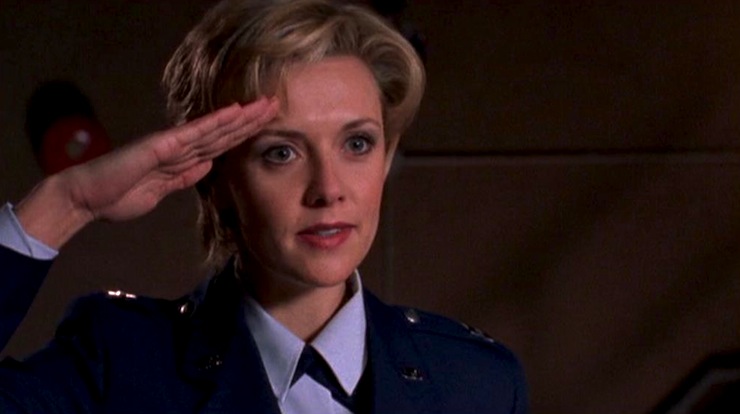
It might work, sir: Carter’s rather up-and-down romantic history is introduced in “The First Commandment,” where we meet her ex-fiancé and he’s a megalomaniacal douche. Her flirtation with Narim of the Tollan kicks off in “Enigma,” at the end of which Carter gives Narim a cat. We also see Carter’s ability to take charge and kick ass (presaging her eventually taking over SG-1 in season 8, commanding Atlantis base in SGA season 4, and commanding her own ship as seen in SGU) in “Hathor” when the men are, ah, indisposed.
I speak 23 different languages—pick one: Jackson has his heart ripped out in the very first episode, as his blissful life on Abydos is yanked away from him by Apophis, who turns his wife and brother-in-law into Goa’uld. His knowledge of history and language proves very useful in making first contact with everyone from the primitive Land of Light (“The Broca Divide”) to the advanced Tollan (“Enigma”).

Indeed: Teal’c sacrifices everything to join SG-1—the depth of this sacrifice isn’t seen until “Bloodlines”—and proves a useful source of information, not to mention his ability to kick major ass.
You have a go: Far from the hardliner cliché of a military general, Hammond shows compassion and intelligence from the beginning, expertly manipulating O’Neill into telling the truth about what happened on Abydos in “Children of the Gods,” but refusing to kill thousands of innocents. He does everything he can to protect the people under his command, including performing that most important of tasks a supervisor can do: being a shit umbrella, keeping the crap from on high from affecting those below him. (Though that umbrella gets a few holes in it thanks to Kinsey in “Politics.”)
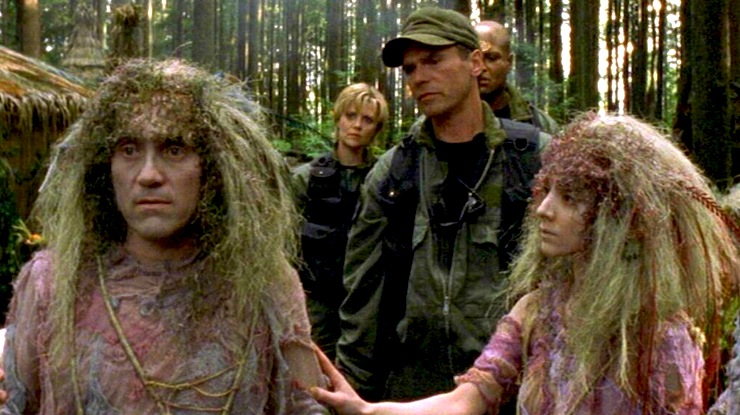
Wayward home for out-of-work genre actors: Armin Shimerman (Quark on Star Trek: Deep Space Nine and Principal Snyder on Buffy the Vampire Slayer) appears as one of the Nox in that species’ eponymous episode. Robert Wisden, veteran of The X-Files and Highlander, among others, appears twice as Samuels. And Ronny Cox, famous for his roles as antagonistic characters in RoboCop and in Star Trek: The Next Generation’s “Chain of Command” two-parter, makes his first of many appearances as Senator Robert Kinsey.
Trivial matters: Several characters from Stargate are carried over, all but one of whom are re-cast: O’Neill, Jackson, Skaara, Sha’re, Kawalsky, Ferretti, Sara O’Neill, and both Catherine and Paul Langford. Alexis Cruz (Skaara) is the only actor who reprises his role, while Richard Dean Anderson and Michael Shanks play O’Neill and Jackson, with Jay Acovone and Brent Stait playing Kawalsky and Ferretti, Harley Jane Kozak playing Sara, and Elizabeth Hoffman (Catherine) and Duncan Fraser (Paul) playing the Langfords.
Ra’s species is given the name of Goa’uld, and it’s established that Ra wasn’t the only one who set him-or-herself up as a mythological god—this season, we meet both Apophis and Hathor. The aliens who possess humans are established as being serpentine, and the Jaffa host the larval form until they mature and take a host.
Several items from the film are seen again, like the Goa’uld mothership, the Jaffa, the hand device, the staff weapon, the sarcophagus, the MALP, and more, plus we get new stuff like the DHD, the healing device, the zat’nikatels, etc.
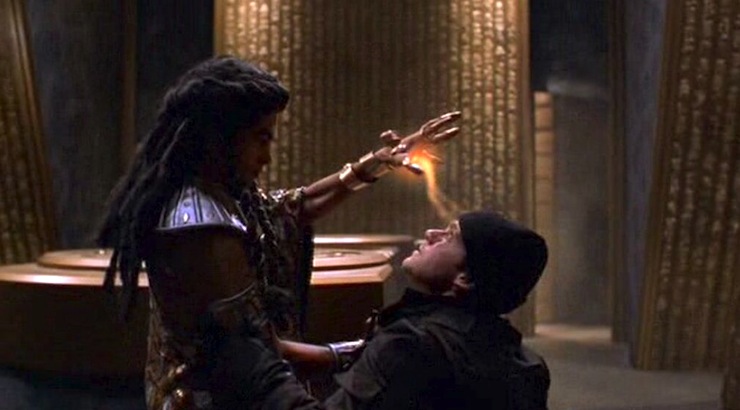
The base where the Stargate is kept is now Cheyenne Mountain rather than Creek Mountain (though it’s explicitly stated to be the same facility), the Langford family no longer speak with accents, and Abydos is now very proximate to Earth instead of “on the far side of the universe.”
Roc Books published two lines of Stargate novels—spinoffs of the film, written by Bill McCay, which did not tie into the TV series in any way, and SG-1 novels written by Ashley McConnell. The latter included a novelization of “Children of the Gods” and three original novels.
O’Neill’s deceased son is given the name of Tyler in the film, but is named Charlie in the series. (In McCay’s novels, he was named Jack O’Neill Jr.)
Chevron seven locked: A relatively strong first season. It’s harder to rewatch this season now after the extensive history that the franchise has developed in the ensuing years. It’s also kind of hilarious how badly they stumble through their explorations. Basically, they don’t do anything sensible until they do something stupid, realize it’s stupid, and fix it—which wouldn’t be so bad if they didn’t endanger the entire planet every time they did something stupid.
On the other hand, at least they learn from their mistakes—so they can make newer, more interesting mistakes! But we see the progress they make as they figure out how to be explorers and also prepare for what might happen.
A lot of what’s best about SG-1 really isn’t on display here—or if it is, it’s only seen briefly. Episodes like “Enigma,” “The Nox,” “Thor’s Hammer,” and “The Torment of Tantalus” do a wonderful job of setting up future storylines, but it’s mostly throwing stuff against a wall. For all that Apophis is supposed to be the big bad, he really only shows up at the beginning and end of the season, plus once in the middle (“The Nox”). The notion of a whole mess of Goa’uld out there isn’t really explored yet, beyond Hathor’s appearance.
But even as the writing is feeling its way around to what the show will become, the acting is already pretty solid.
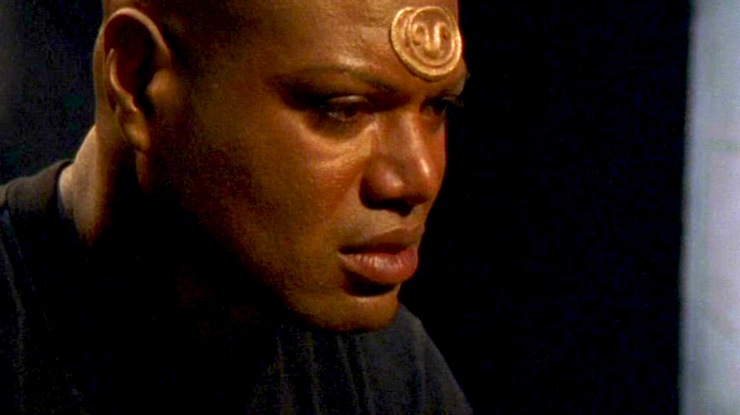
Christopher Judge manages to convey a great deal with his varying facial expressions, from the subtle torment in “Children of the Gods” as he does awful things in Apophis’s name, which O’Neill picks up on and encourages, to the out-and-out anguish when he’s put on trial in “Cor-ai.”
Michael Shanks starts out doing a great James Spader impersonation and slowly makes the role his own, in particular allowing the character a great range of emotion, from the pain of Sha’re’s kidnapping in the pilot to the wonder of discovery in “The Torment of Tantalus” to his frustrated outrage at what he saw in “There But for the Grace of God…” and the inability of anyone to appreciate it to his satisfaction in “Politics” and “Within the Serpent’s Grasp.”
Richard Dean Anderson does no kind of Kurt Russell impersonation, and moves farther away from the chain-smoking hardass of the film, playing him more like the cynical-but-compassionate leader. But he has his demons, mostly seen in his anguish at Skaara’s kidnapping in “Children of the Gods” and “Within the Serpent’s Grasp,” and he does more with the pain of his son’s death in “Cold Lazarus” than Russell managed in the entire movie.
But the breakout here is Amanda Tapping, whose Samantha Carter is one of the finest characters to grace the science fiction television landscape. She’s brilliant, resourceful, modest (every time she proposes a theory or hypothesis, she qualifies it up the kazoo, is sure to explain how badly it can go wrong, and refuses to gloat when it succeeds), tough, clever, and a huge asset to SG-1. It took the writers a while to get a handle on her—her initial dialogue with O’Neill, Kawalsky, and Ferretti in “Children of the Gods” is embarrassingly clumsy (to the show’s credit, they’d make fun of the reproductive organs line several times in the future), and her earliest spotlights in “The First Commandment” and “Emancipation” show an appalling lack of imagination—but as the season goes on you can see the greatness that will develop. In particular, she makes the overdone men-are-bamboozled plot of “Hathor” work (aided and abetted by Teryl Rothery’s Janet Fraiser, who would go on to become a critical supporting character) with her no-nonsense military approach.
Keith R.A. DeCandido is hard at work on Kali’s Wrath, an SG-1 novel taking place in the fifth season. His Carter-and-Teal’c story “Time Keeps on Slippin’” can be seen in the anthology Far Horizons.










